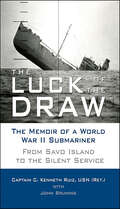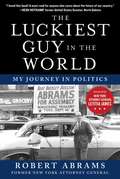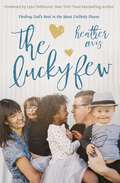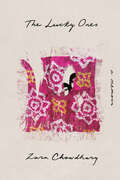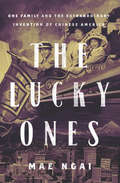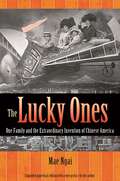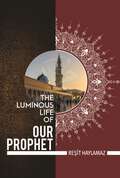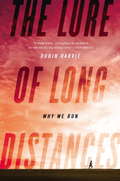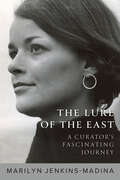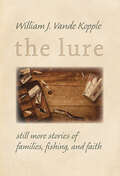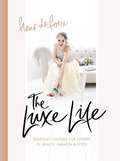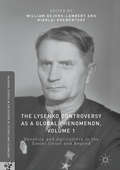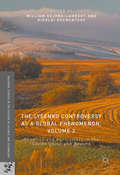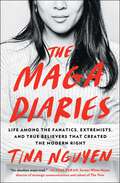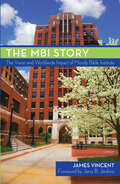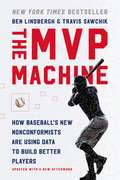- Table View
- List View
The Luck of the Draw: The Memoir of a World War II Submariner: From Savo Island to the Silent Service
by John Bruning C. Kenneth RuizA coin flip likely saved the life of Kenneth C. Ruiz. It was August 1942 and he was fresh out of the U.S. Naval Academy. He and a classmate flipped a coin to see who would stand watch on the bridge of their heavy cruiser, the USS Vincennes, off Savo Island as the Marines were landing on Guadalcanal. Ruiz was on the bridge when the ship took a direct hit and sank. He ended up in the Pacific without a life jacket, but his classmate and the entire radio room crew perished in the attack. "The luck of the draw" is a recurring theme in this powerful memoir. Following the demise of the Vincennes, Ruiz volunteered to serve on submarines for the balance of the war and had numerous harrowing experiences. He spent most of his time on the USS Pollack, which was sub-standard in terms of technology, but was still deadly and made a significant impact on Japanese shipping in the far reaches of the Pacific. A worthy addition to the litany of WWII books on submariners, The Luck of the Draw is filled with heartbreaking stories of how the smallest decisions made the difference between life and death for soldiers and sailors in the war.
The Luckiest Guy in the World: My Journey in Politics
by Robert AbramsThe Remarkable True Story of Robert Abrams, the man who changed the New York Attorney General's Office for Good. At the heart of this political memoir is the story of how the office of state attorney general, an historically sleepy backwater post, has evolved into a front line major protector of the rights of citizens across the country. New York State Attorney General Robert Abrams exercised leadership in organizing attorneys general throughout the nation to take collective action against the Reagan administration&’s punishing laissez-faire anti-regulatory policies. Abrams and his fellow attorneys general set the precedent for the successful challenges mounted by today&’s attorneys general against the Trump administration&’s immigration policies and rollback of consumer and civil rights protections. Through lively anecdotes, Abrams captures the Bronx of his childhood, his early insurgent grassroots campaigns taking on the powerful Democratic Party machine, the urban challenges of being Bronx Borough President, the turbulent Vietnam anti-war years, and the beginnings of the environmental justice movement. He revisits the explosive Tawana Brawley case where an African American teenage girl alleged rape and brutality by a group of white men that included law enforcement officials. Abrams provides behind-the-scenes interactions with important figures ranging from Golda Meir, George McGovern, Mario Cuomo, Robert Moses, and Cesar Chavez to Shirley Chisholm. The book demonstrates how ordinary people battling unequal odds against corporate and other powerful forces can prevail when laws are enforced to protect their rights. A chapter about the infamous Love Canal case details the shocking revelation that buried beneath the seemingly placid upstate New York working class community lay tons of toxic waste spawning chronic health problems for residents. Abrams in a landmark lawsuit took on Occidental Petroleum for its callous actions, paved the way for the passage of the Superfund Act and a victory for the emerging environmental justice movement. He describes dramatic confrontations with the radical anti-abortion group, Operation Rescue, and its increasingly violent efforts to deny a woman&’s right to choose. His courageous, path-breaking support of LGBT rights, seeking to end the prevailing bigotry with legal victories that ultimately led to marriage equality is also revisited. In The Luckiest Guy in the World, Robert Abrams wears his progressive values on his sleeve, providing an optimistic view about our nation&’s return to its fundamental values. Visit luckiestguyintheworldbobabrams.com for more information.
The Luckiest Man: Life with John McCain
by Mark SalterA deeply personal and candid remembrance of the late Senator John McCain from one of his closest and most trusted confidants, friends, and political advisors. More so than almost anyone outside of McCain&’s immediate family, Mark Salter had unparalleled access to and served to influence the Senator&’s thoughts and actions, cowriting seven books with him and acting as a valued confidant. Now, in The Luckiest Man, Salter draws on the storied facets of McCain&’s early biography as well as the later-in-life political philosophy for which the nation knew and loved him, delivering an intimate and comprehensive account of McCain&’s life and philosophy. Salter covers all the major events of McCain&’s life—his peripatetic childhood, his naval service—but introduces, too, aspects of the man that the public rarely saw and hardly knew. Woven throughout this narrative is also the story of Salter and McCain&’s close relationship, including how they met, and why their friendship stood the test of time in a political world known for its fickle personalities and frail bonds. Through Salter&’s revealing portrayal of one of our country&’s finest public servants, McCain emerges as both the man we knew him to be and also someone entirely new. Glimpses of his restlessness, his curiosity, his courage, and sentimentality are rendered with sensitivity and care—as only Mark Salter could provide. The capstone to Salter&’s intimate and decades-spanning time with the Senator, The Luckiest Man is the authoritative last word on the stories McCain was too modest to tell himself and an influential life not soon to be forgotten.
The Lucky Few: Finding God's Best in the Most Unlikely Places
by Heather Avis Lysa TerKeurst, New York Times bestselling authorThese are the faces that call me “mom,” the three children who made me a mother. When I started my journey into parenthood I never thought it would look like this. I never planned on having three adopted children, and I certainly never imagined that two of them would have Down syndrome. But like most of the things God does, once we stepped into the craziness and confusion of the unknown and unplanned, we quickly realized that we were indeed among the lucky few. When my husband and I decided to grow our family ten years ago, we were surprised to find that getting pregnant was not as easy as we had thought it would be. And as we navigated the ups and downs of infertility, God led us down the path of adoption. Of course, we would adopt! Not what we had originally planned, but certainly a wonderful option. But just as we began to get a comfortable grasp on growing our family through adoption, God introduced us to Macyn Hope, a very sick little girl with Down syndrome who desperately needed a family. As we continued to follow God’s calling, first with Macyn, and later with Truly and then August, we found ourselves further and further from the comfortable paths we thought our lives would take, and instead moving down some very scary, and often painful roads. Even though at times His plan seemed terrifying and even downright foolish, little could we have known how much goodness, blessing, and joy would flow out of loving these three little people He’s put into our lives. No, it’s not been easy: not the open-heart surgeries or the challenges of raising two children with Down syndrome or the complexities of dealing with birth-families or the struggles we’ve had with the public education system. But through it all, every new and uncomfortable situation has only proven to be another chance to see how very good God’s plan is for our lives and how downright lucky we are to be able to live it out. It’s only the lucky few that recognize that the most beautiful things in this life are often found in the differences. What some would see as misfortune, I’ve learned to see as nothing more than pure luck.
The Lucky Ones
by Jenny BrownJonathan Safran Foer meets Jeffrey Moussaieff Mason in a poignant, provocative memoir of survival, compassion, and awakening to the reality of our food system. Jenny Brown was ten years old when she lost a leg to bone cancer. Throughout the ordeal, her constant companion was a cat named Boogie. Years later, she would make the connection between her feline friend and the farm animals she ate, acknowledging that most of America's domesticated animals live on industrialized farms, and are viewed as mere production units. Raised in a conservative Southern Baptist family in Kentucky, Brown had been taught to avoid asking questions. But she found her passion and the courage to speak out. The Lucky Ones introduces readers to Woodstock Farm Animal Sanctuary which Brown established with her husband in 2004. With a cast of unforgettable survivors, including a fugitive slaughterhouse cow named Kayli; Albie, the three-legged goat; and Quincy, an Easter duckling found abandoned in New York City, The Lucky Ones reveals shocking statistics about the prevalence of animal abuse throughout America's agribusinesses. Blending wry humor with unflinching honesty, Brown brings a compelling new voice to the healthy-living movement--and to the vulnerable, voiceless creatures among us.
The Lucky Ones: A Memoir
by Zara ChowdharyA moving memoir by a survivor of anti-Muslim violence in contemporary India that delicately weaves political and family histories in a tribute to her country&’s unique Islamic heritage—&“a must-read in our warring world today&” (NPR)&“A harrowing survivor&’s tale, an important history lesson, and a desperate warning from someone who has seen the tragic effects of ethnic violence.&”—TimeIn 2002, Zara Chowdhary is sixteen years old and living with her family in Ahmedabad, one of India&’s fastest-growing cities, when a gruesome train fire claims the lives of sixty Hindu right-wing volunteers and upends the life of five million Muslims. Instead of taking her school exams that week, Zara is put under a three-month siege, with her family and thousands of others fearing for their lives as Hindu neighbors, friends, and members of civil society transform overnight into bloodthirsty mobs, hunting and massacring their fellow citizens. The chief minister of the state at the time, Narendra Modi, will later be accused of fomenting the massacre, and yet a decade later, will rise to become India&’s prime minister, sending the &“world&’s largest democracy&” hurtling toward cacophonous Hindu nationalism. The Lucky Ones traces the past of a multigenerational Muslim family to India&’s brave but bloody origins, a segregated city&’s ancient past, and the lingering hurt causing bloodshed on the streets. Symphonic interludes offer glimpses into the precious, ordinary lives of Muslims, all locked together in a crumbling apartment building in the city&’s old quarters, with their ability to forgive and find laughter, to offer grace even as the world outside, and their place in it, falls apart. The Lucky Ones entwines lost histories across a subcontinent, examines forgotten myths, prods a family&’s secrets, and gazes unflinchingly back at a country rushing to move past the biggest pogrom in its modern history. It is a warning thrown to the world by a young survivor, to democracies that fail to protect their vulnerable, and to homes that won&’t listen to their daughters. It is an ode to the rebellion of a young woman who insists she will belong to her land, family, and faith on her own terms.
The Lucky Ones: One Family and the Extraordinary Invention of Chinese America
by Mae NgaiIf you're Irish American or African American or Eastern European Jewish American, there's a rich literature to give you a sense of your family's arrival-in-America story. Until now, that hasn't been the case for Chinese Americans. From noted historian Mae Ngai, The Lucky Ones uncovers the three-generational saga of the Tape family. It's a sweeping story centered on patriarch Jeu Dip's (Joseph Tape's) self-invention as an immigration broker in post-gold rush, racially explosive San Francisco, and the extraordinary rise it enables. Ngai's portrayal of the Tapes as the first of a brand-new social type--middle-class Chinese Americans, with touring cars, hunting dogs, and society weddings to broadcast it--will astonish. Again and again, Tape family history illuminates American history. Seven-year-old Mamie Tape attempts to integrate California schools, resulting in the landmark 1885 Tape v. Hurley. The family's intimate involvement in the 1904 St. Louis World's Fair reveals how the Chinese American culture brokers essentially invented Chinatown--and so Chinese culture--for American audiences. Finally, Mae Ngai reveals aspects--timely, haunting, and hopeful--of the lasting legacy of the immigrant experience for all Americans.
The Lucky Ones: One Family and the Extraordinary Invention of Chinese America - Expanded paperback Edition
by Mae M. NgaiThe Lucky Ones uncovers the story of the Tape family in post-gold rush, racially explosive San Francisco. Mae Ngai paints a fascinating picture of how the role of immigration broker allowed patriarch Jeu Dip (Joseph Tape) to both protest and profit from discrimination, and of the Tapes as the first of a new social type--middle-class Chinese Americans. Tape family history illuminates American history. Seven-year-old Mamie attempts to integrate California schools, resulting in the landmark 1885 case Tape v. Hurley. The family's intimate involvement in the 1904 St. Louis World's Fair reveals how Chinese American brokers essentially invented Chinatown, and so Chinese culture, for American audiences. Finally, The Lucky Ones reveals aspects--timely, haunting, and hopeful--of the lasting legacy of the immigrant experience for all Americans. This expanded edition features a new preface and a selection of historical documents from the Chinese exclusion era that forms the backdrop to the Tape family's story.
The Luminous Life of Our Prophet
by Resit HaylamazDespite hundreds of years that have passed by, Prophet Muhammad (pbuh) remains fresh in the hearts and minds of millions of people. The Luminous Life of Our Prophet is a book which aims to keep fresh the noble personality of the last Prophet by giving insights into his family as a loving father and husband, and his social life as a leader and mediator, and his spiritual life as a devoted servant of Allah the Almighty.
The Lumley Autograph
by Susan Fenimore CooperA satirical work concerning the autograph collecting mania of the mid-nineteenth century.
The Lure and Legacy of Music at Versailles
by John Hajdu HeyerLouis XIV and his court at Versailles had a profound influence on music in France and throughout Europe. In 1660 Louis visited Aix-en-Provence, a trip that resulted in political and cultural transformations throughout the region. Soon thereafter Aix became an important center of sacred music composition, eventually rivaling Paris for the quality of the composers it produced. John Hajdu Heyer documents the young king's visit and examines how he and his court deployed sacred music to enhance the royal image and secure the loyalty of the populace. Exploring the circle of composers at Aix, Heyer provides the most up-to-date and complete biographies in English of nine key figures, including Guillaume Poitevin, André Campra, Jean Gilles, François Estienne, and Antoine Blanchard. The book goes on to reveal how the history of political power in the region was reflected through church music, and how musicians were affected by contemporary events.
The Lure of Long Distances: Why We Run
by Robin HarvieThe stunning sequel to James Smythee(tm)s critically acclaimed literary sci-fi novel The Explorer. TWENTY YEARS following the disappearance of the infamous Ishiguro e" the first manned spacecraft to travel deeper into space than ever before e" humanity are setting their sights on the heavens once more. Under the direction of two of the most brilliant minds science has ever seen e" that of identical twin brothers Tomas and Mirakel Hyvnen e" this space craft has a bold mission: to study what is being called e~the anomalye(tm) e" a vast blackness of space into which the Ishiguro disappeared. Between them Tomas (on the ground, guiding the mission from the command centre) and Mira (on the ship, with the rest of the hand-picked crew) are leaving nothing to chance. But soon these two scientists are to learn that there are some things in space beyond our understanding. As the anomaly begins to test the limits of Mirae(tm)s comprehension e" and his sanity e" will Tomas be able to save his brother from being lost in space too?
The Lure of the East: A Curator's Fascinating Journey
by Marilyn Jenkins-MadinaThe remarkable journey of one of the first women to become a curator of Islamic art at The Metropolitan Museum of Art and an internationally recognized scholar in the field. As a girl growing up in Frenchtown, New Jersey, Marilyn Jenkins-Madina recalls first learning about the Egyptian pyramids in sixth grade. That discovery opened her mind to the possibility of not only learning more about worlds far removed from her small-town existence, but of actually experiencing them and living them. Throughout her life, opportunities to follow uncharted roads have presented themselves in ways that she has not dismissed. It has been the driving force in her career and her life. She became a curator of Islamic art at The Metropolitan Museum of Art and an internationally recognized scholar in the field. She took more than 50 international trips, most of which were to the Middle East, at times and in locations where women were not exactly respected or welcomed in a capacity of authority. She came to enjoy an enduring friendship with Kuwaiti royalty. And, last but certainly not least, she became the wife and partner-in-adventure of a wonderful gentleman from Damascus who was a professor at Columbia University and also a Kurdish agha. From the banks of the Delaware to the shores of the Arabian Gulf and beyond, The Lure of the East: A Curator's Fascinating Journey is the story of her remarkable journey. Dr. Jenkins-Madina began her long curatorial career at The Metropolitan Museum of Art, New York in 1964. Having received her B.A. from Brown University in 1962, she continued to pursue her education while working at The Metropolitan Museum, earning both her M.A. and Ph.D. during this time. From her initial appointment as Curatorial Assistant, she rose through the ranks during her forty-year tenure as curator in the Department of Islamic Art and was named Curator Emerita upon her retirement in 2004. This memoir is meant to inspire others to dare to take their own road less traveled.
The Lure: Still More Stories of Families, Fishing, and Faith
by William J. Vande KoppleThey say that a fisherman never runs out of stories. Lucky for readers of this book, William J. Vande Kopple wants to do more than regale us with tales of the one that got away. In this winsome collection, Vande Kopple spins fifteen funny, poignant yarns out of his experience as a father, angler, and believer. From its haunting opening vignette to more expansive recollections of road trips, family reunions, and solitary forays into nature, Vande Kopple effortlessly perceives the connections between families, fishing, and faith. He is steadfast in his faith yet comfortable with doubt (see the starkly untidy ending of "Not a Hair Shall Fall," in which he and his son wrestle with both a big fish and the question of God's providence). He is contagiously exuberant yet mindful of the vicissitudes of aging (Have I waited too long? he wonders after a much-delayed fishing trip with his father in "Time Is Tapping on My Forehead"). He is an able raconteur whose spirits are never dampened for long (in "Longing," he promises never to drive up to Canada on a whim again to fish-until the locals tell him about a river he just has to try). Fishermen and their longsuffering friends and family members will relish Vande Kopple's latest book. So, too, will nature lovers of all stripes-particularly those who know the beauty of the pristine wildernesses of Michigan and Northwestern Ontario. In any case, whether or not readers share Vande Kopple's love for fishing, these stories are sure to catch those who are angling for a good story!
The Luxe Life: Everyday Luxuries for Lovers of Beauty, Fashion & Food
by Fleur De ForceEvery girl deserves a little bit of luxe in her life and top beauty and fashion vlogger Fleur de Force - Sunday Times bestselling author of The Glam Guide - knows exactly how to get it."Luxe living is all about becoming your best self - the one you've always wanted to be - and making it look effortless. It's about making every day feel special and knowing that a little bit of extra effort in any aspect of your life goes a long way. This is my lifestyle bible for girls who want to make The Luxe Life a reality, regardless of budget or time constraints."Packed with:- Inspiring fashion and beauty advice- Budget-friendly hosting hacks- Lifestyle tips to make your home a sanctuary- Creative and thoughtful DIY gift ideas- Over 30 must-have recipes to take you from brunch to dinner partyThe Luxe Life is the essential guide to wowing at every special occasion, and making every day special.
The Lyrics (Vol. Two-Volume Set): 1956 To The Present
by Paul McCartneyA work of unparalleled candor and splendorous beauty, The Lyrics celebrates the creative life and the musical genius of Paul McCartney through 154 of his most meaningful songs. <P><P> From his early Liverpool days, through the historic decade of The Beatles, to Wings and his long solo career, The Lyrics pairs the definitive texts of 154 Paul McCartney songs with first-person commentaries on his life and music. Spanning two alphabetically arranged volumes, these commentaries reveal how the songs came to be and the people who inspired them: his devoted parents, Mary and Jim; his songwriting partner, John Lennon; his “Golden Earth Girl,” Linda Eastman; his wife, Nancy McCartney; and even Queen Elizabeth, among many others. Here are the origins of “Let It Be,” “Lovely Rita,” “Yesterday,” and “Mull of Kintyre,” as well as McCartney’s literary influences, including Shakespeare, Lewis Carroll, and Alan Durband, his high-school English teacher. <P><P>With images from McCartney’s personal archives—handwritten texts, paintings, and photographs, hundreds previously unseen—The Lyrics, spanning sixty-four years, becomes the definitive literary and visual record of one of the greatest songwriters of all time. <P><P><b>A New York Times Best Seller</b>
The Lyrics: 1956 to the Present
by Paul Muldoon Paul McCartneyA work of unparalleled candor and splendorous beauty, The Lyrics celebrates the creative life and the musical genius of Paul McCartney through his most meaningful songs. <p><p> Finally in paperback and featuring seven new song commentaries, the #1 New York Times bestseller celebrates the creative life and unparalleled musical genius of Paul McCartney. <p><p> Spanning sixty-four years—from his early days in Liverpool, through the historic decade of The Beatles, to Wings and his solo career—Paul McCartney’s The Lyrics revolutionized the way artists write about music. An unprecedented “triumph” (Times UK), this handsomely designed volume pairs the definitive texts of over 160 songs with first-person commentaries on McCartney’s life, revealing the diverse circumstances in which songs were written; how they ultimately came to be; and the remarkable, yet often delightfully ordinary, people and places that inspired them. The Lyrics also includes: <p><p> · A personal foreword by McCartney <p>· An unprecedented range of songs, from beloved standards like “Band on the Run” to new additions “Day Tripper” and “Magical Mystery Tour” <p>· Over 160 images from McCartney’s own archives <p><p> Edited and introduced by Pulitzer Prize-winning poet Paul Muldoon, The Lyrics is the definitive literary and visual record of one of the greatest songwriters of all time. <p> <b>New York Times Bestseller</b>
The Lysenko Controversy as a Global Phenomenon, Volume 1
by William Dejong-Lambert Nikolai KrementsovThis volume covers the global history of the Lysenko controversy, while exploring in greater depth the background of D. Lysenko's career and influence in the USSR. By presenting the rise and fall of T. D. Lysenko in a variety of aspects--his influence upon art, unrecognized predecessors, and the extent to which genetics continued in the USSR even while he was in power, and the revival of his reputation today--the authors provide a fresh perspective on one of the most notorious episodes in the history of science.
The Lysenko Controversy as a Global Phenomenon, Volume 2
by William Dejong-Lambert Nikolai KrementsovThis volume examines the international impact of Lysenkoism in its namesake's heyday and the reasons behind Lysenko's rehabilitation in Russia today. By presenting the rise and fall of T. D. Lysenko in its various aspects, the authors provide a fresh perspective on one of the most notorious episodes in the history of science.
The MAGA Diaries: Life Among the Fanatics, Extremists, and True Believers that Created the Modern Right
by Tina NguyenThis explosive &“must-read for anyone who cares about the future of our democracy&” (Brian Stelter, New York Times bestselling author) chronicles the rise of the MAGA movement from acclaimed political journalist Tina Nguyen, who began her career—and her education—on the ground levels of the conservative recruiting machine.Her very first job was working for a little-known journalist named Tucker Carlson. She&’s chugged Mountain Dews with the first Breitbart writers, poured over conspiracy theories from COVID-19 deniers, and visited the apocalyptic Patriot Church deep in the woods of the Pacific Northwest. The right is now a MAGA cult. And Tina Nguyen knows because she was raised by it, back when it wasn&’t one. In 2008, in the weeks leading up to the election of Barack Obama, Nguyen was a history-loving, politics-obsessed college student at Claremont McKenna College, drawn there by a boyfriend—and a research institute called the Salvatori Center for the Study of Individual Freedom. Swept up by pro-America rhetoric and promises of a career in journalism, Nguyen was drawn into the world of right-wing student activism, and the early days of the movement now known as MAGA. In The MAGA Diaries, she tells not only her story of loving and leaving the conservative movement but the history of the right wing, painting a shocking picture of how they recruit, train, and indoctrinate generations of young people and shape them into the influential leaders and the supporting cast of tomorrow&’s Republican party. They are ruthless in building robust networks of power, even if it means demolishing entire civic institutions, from women&’s rights to fair elections—and staging a coup when it doesn&’t work out. In this &“sobering, endlessly readable fly-on-the-wall account of creeping fascism&” (Kirkus Reviews, starred review), Nguyen pulls back the curtain on the conservative machine, shining a light on the systematized on-ramp for young Republicans. These are the new leaders of the right, and it&’s urgent we start paying attention.
The MBI Story: The Vision and Worldwide Impact of the Moody Bible Institute
by James VincentMoody Bible Institute will celebrate 125 years of ministry in 2011. The "official" history of MBI is being updated by Jim Vincent, to be released in time for Founder's Week in February, 2011. Jim Vincent (BA, UCLA; MA, UIC), was a member of faculty, an editor of Moody Magazine, and is today a senior editor for Moody Publishers. Jim helped update The Story of MBI (released in 1986), and has written Parting the Waters and co-authored A Vision with Wings. This volume will be the most comprehensive, up to date review of the history, ministry and impact of the Moody Bible Institute of Chicago. A four color photo insert is planned, along with a helpful appendix with the original constitution and bylaws, as well as a timeline of significant dates and events.
The MBI Story: The Vision and Worldwide Impact of the Moody Bible Institute
by James VincentMoody Bible Institute will celebrate 125 years of ministry in 2011. The "official" history of MBI is being updated by Jim Vincent, to be released in time for Founder's Week in February, 2011. Jim Vincent (BA, UCLA; MA, UIC), was a member of faculty, an editor of Moody Magazine, and is today a senior editor for Moody Publishers. Jim helped update The Story of MBI (released in 1986), and has written Parting the Waters and co-authored A Vision with Wings. This volume will be the most comprehensive, up to date review of the history, ministry and impact of the Moody Bible Institute of Chicago. A four color photo insert is planned, along with a helpful appendix with the original constitution and bylaws, as well as a timeline of significant dates and events.
The MVP Machine: How Baseball's New Nonconformists Are Using Data to Build Better Players
by Ben Lindbergh Travis SawchikMove over, Moneyball -- a cutting-edge look at major league baseball's next revolution: the high-tech quest to build better players. As bestselling authors Ben Lindbergh and Travis Sawchik reveal in The MVP Machine, the Moneyball era is over. Fifteen years after Michael Lewis brought the Oakland Athletics' groundbreaking team-building strategies to light, every front office takes a data-driven approach to evaluating players, and the league's smarter teams no longer have a huge advantage in valuing past performance.Lindbergh and Sawchik's behind-the-scenes reporting reveals:How the 2017 Astros and 2018 Red Sox used cutting-edge technology to win the World SeriesHow undersized afterthoughts José Altuve and Mookie Betts became big sluggers and MVPsHow polarizing pitcher Trevor Bauer made himself a Cy Young contenderHow new analytical tools have overturned traditional pitching and hitting techniquesHow a wave of young talent is making MLB both better than ever and arguably worse to watchInstead of out-drafting, out-signing, and out-trading their rivals, baseball's best minds have turned to out-developing opponents, gaining greater edges than ever by perfecting prospects and eking extra runs out of older athletes who were once written off. Lindbergh and Sawchik take us inside the transformation of former fringe hitters into home-run kings, show how washed-up pitchers have emerged as aces, and document how coaching and scouting are being turned upside down. The MVP Machine charts the future of a sport and offers a lesson that goes beyond baseball: Success stems not from focusing on finished products, but from making the most of untapped potential.
The Macneils of Tokyo
by Jack SewardIn the absorbing, epic tradition of The Winds of War, author Jack Seward presents a new novel of war, passion, and divided family loyalties. The MacNeil family is torn apart by the horrors of war, which is consuming Asia as strife, intrigue, and romance inevitably follow. Like its predecessor, The MacNeils of Nagasaki, this lively novel is a storytelling gem from a prolific author, a perfect beach read for all lovers of family sagas, historical fiction, and gripping adventure novels.
